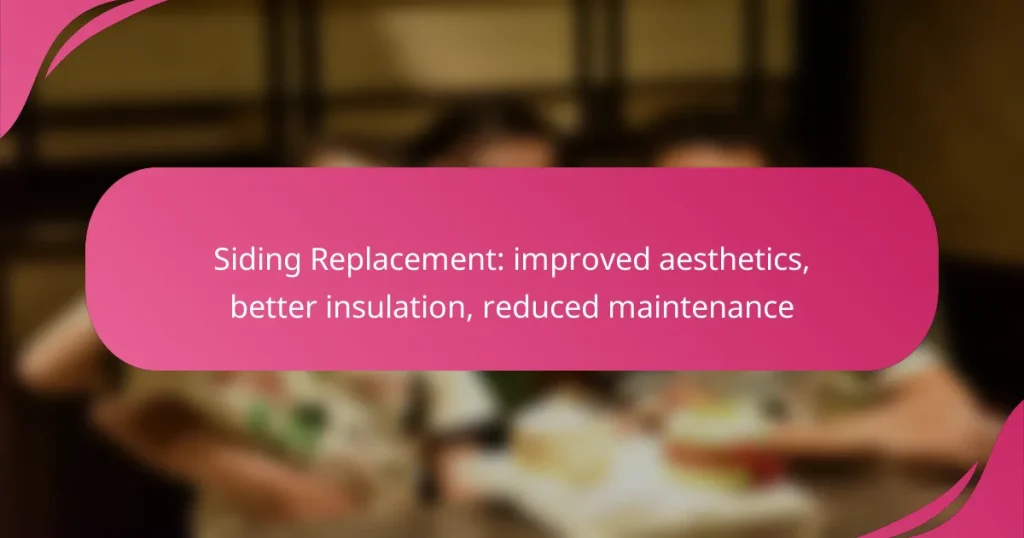Siding replacement is a transformative investment for homeowners, significantly enhancing aesthetics while improving insulation and reducing maintenance requirements. By choosing the right materials, such as vinyl or fiber cement, you can ensure your home not only looks appealing but also withstands the challenges of the Canadian climate. This upgrade not only boosts your property’s curb appeal but also contributes to long-term energy savings and comfort.
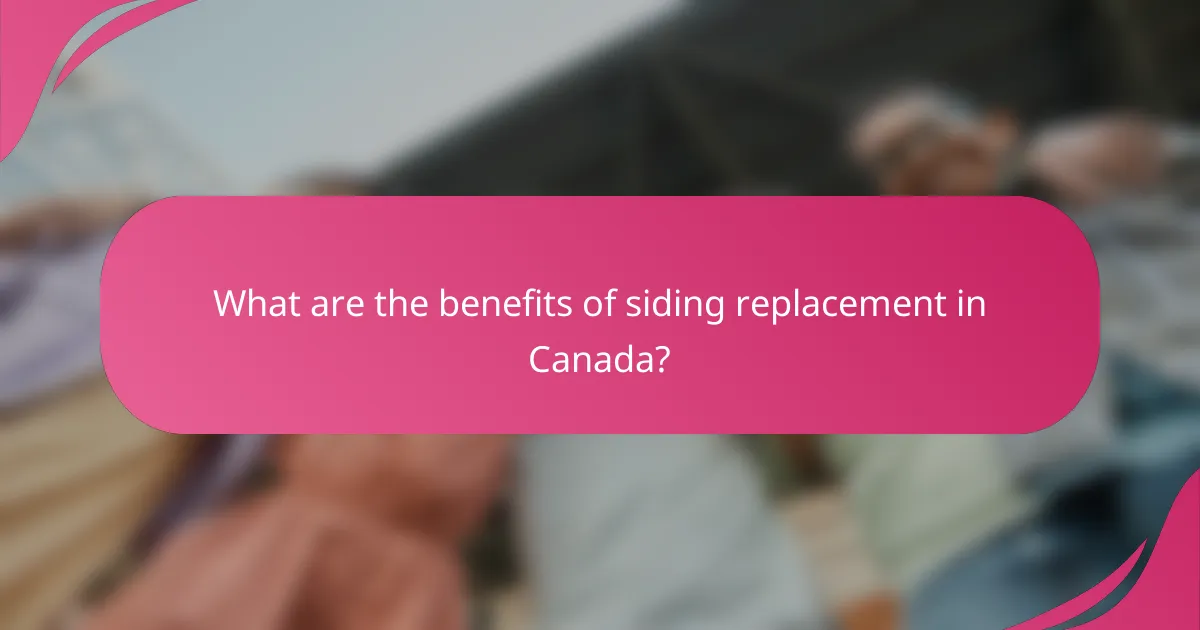
What are the benefits of siding replacement in Canada?
Siding replacement in Canada offers significant advantages, including enhanced curb appeal, improved energy efficiency, and lower maintenance needs. These benefits not only elevate the aesthetic value of your home but also contribute to long-term savings and comfort.
Improved aesthetics with modern materials
Replacing your siding can dramatically enhance your home’s appearance. Modern materials such as vinyl, fiber cement, and engineered wood come in various colors and textures, allowing homeowners to achieve a customized look that suits their style.
Consider options like horizontal or vertical panels, shingles, or board-and-batten styles. These choices can transform a dated exterior into a contemporary masterpiece, increasing your home’s market value.
Enhanced insulation for energy efficiency
New siding can significantly improve your home’s insulation, leading to better energy efficiency. Insulated siding options can reduce heat loss during cold Canadian winters and keep your home cooler in the summer, potentially lowering your energy bills by a noticeable margin.
When selecting siding, look for materials with high R-values, which indicate better thermal resistance. Additionally, consider adding insulation beneath the siding for even greater energy savings.
Reduced maintenance with durable options
Modern siding materials are designed to withstand the elements, requiring less upkeep than traditional options. For instance, vinyl siding is resistant to fading, cracking, and peeling, while fiber cement is known for its durability against pests and rot.
Choosing low-maintenance siding can save you time and money over the years. Regular cleaning with soap and water is typically all that’s needed, allowing you to enjoy your home without the hassle of frequent repairs or repainting.
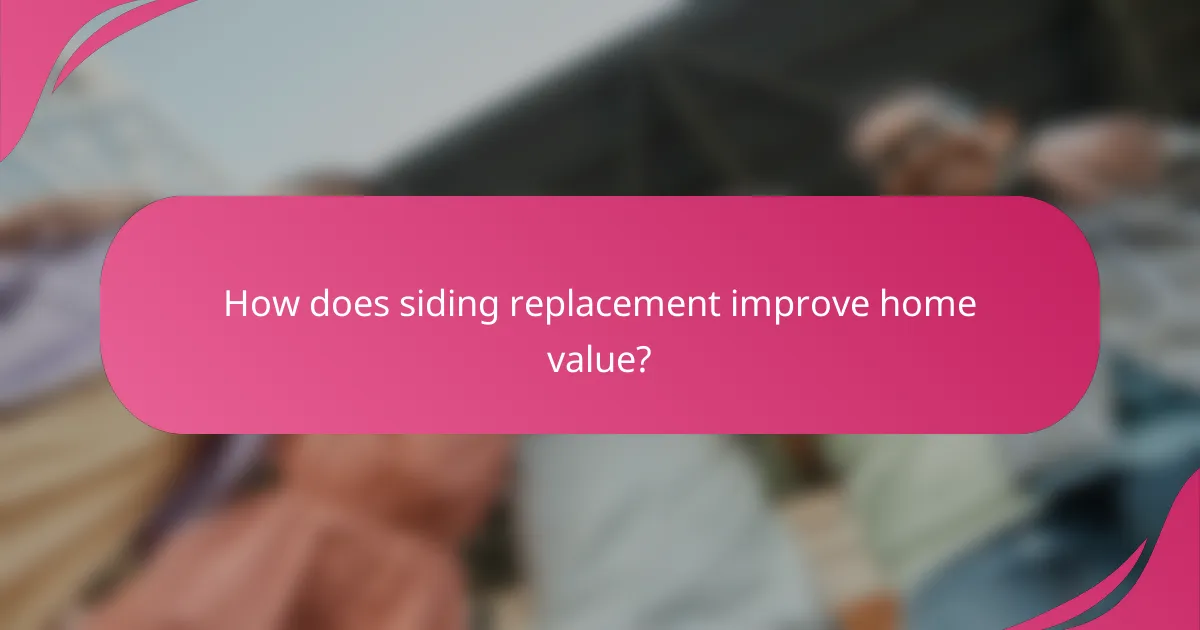
How does siding replacement improve home value?
Siding replacement enhances home value by boosting aesthetics, increasing energy efficiency, and reducing maintenance needs. These improvements can make a significant difference in how a property is perceived and its overall market appeal.
Increased curb appeal
New siding dramatically enhances a home’s curb appeal, which is the first impression potential buyers have. Fresh, modern materials and colors can make a house look more inviting and well-maintained. Consider using popular siding options like vinyl or fiber cement, which are known for their durability and aesthetic versatility.
Choosing a color that complements the neighborhood can further elevate curb appeal. Homes with attractive exteriors often stand out, making them more appealing in competitive real estate markets.
Higher resale value
Replacing siding can lead to a higher resale value, often recouping a significant portion of the investment. Homeowners can expect to recover around 70-80% of their siding replacement costs when selling, depending on the material and local market conditions. This makes siding replacement a financially sound decision for many homeowners.
Investing in high-quality materials can enhance this return, as buyers are often willing to pay more for homes that require less immediate maintenance and offer better energy efficiency.
Attractiveness to potential buyers
New siding makes a home more attractive to potential buyers by signaling that the property has been well cared for. Buyers are often deterred by homes that appear outdated or in disrepair, so modern siding can create a positive perception. Features like energy-efficient insulation can also appeal to environmentally conscious buyers.
Additionally, showcasing the benefits of new siding, such as lower maintenance and improved insulation, can further entice buyers. Highlighting these advantages during showings can help a home stand out in the market.

What types of siding are best for Canadian climates?
For Canadian climates, the best siding options are those that provide excellent insulation, withstand harsh weather, and require minimal upkeep. Vinyl, fiber cement, and wood siding each offer unique benefits suited to the diverse Canadian environment.
Vinyl siding for low maintenance
Vinyl siding is a popular choice in Canada due to its low maintenance requirements. It resists fading, peeling, and cracking, making it ideal for regions with extreme temperature fluctuations.
Homeowners can expect to clean vinyl siding occasionally, but it does not require painting or staining. This durability can save money over time, as replacement costs are lower compared to other materials.
Fiber cement for durability
Fiber cement siding is known for its exceptional durability, making it suitable for the Canadian climate. It can withstand heavy snow, rain, and wind without warping or deteriorating.
This type of siding is fire-resistant and can last several decades with proper installation. While it may require some maintenance, such as repainting every 10 to 15 years, its longevity often justifies the initial investment.
Wood siding for aesthetic appeal
Wood siding offers a classic and attractive look, enhancing the curb appeal of homes in Canada. It can be customized with various stains and finishes to match personal preferences.
However, wood siding requires more maintenance compared to vinyl and fiber cement. Regular painting or staining is essential to protect it from moisture and pests, making it a less practical choice for some homeowners.
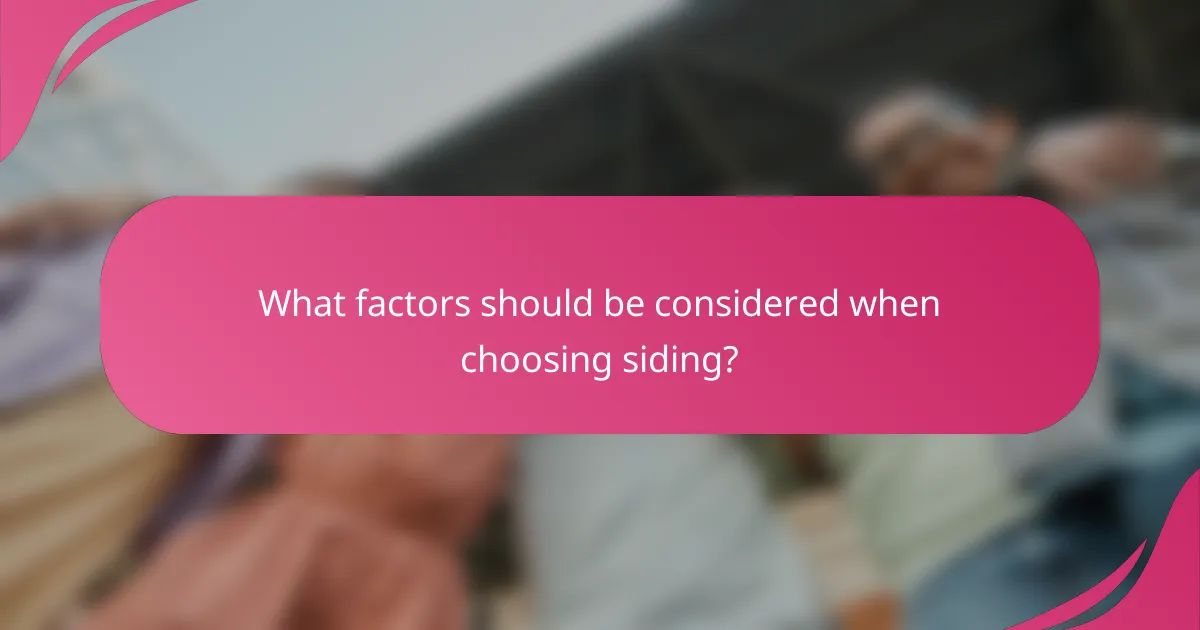
What factors should be considered when choosing siding?
When selecting siding, consider climate suitability, cost, and maintenance requirements. Each factor significantly impacts the durability, appearance, and overall performance of your home’s exterior.
Climate suitability
Climate suitability is crucial when choosing siding, as different materials perform better in specific weather conditions. For instance, vinyl siding is resistant to moisture, making it ideal for humid areas, while wood siding may be better suited for dry climates.
Evaluate local weather patterns, including temperature fluctuations, precipitation, and wind exposure. This assessment helps ensure that the siding you choose can withstand the elements and maintain its appearance over time.
Cost and budget
Cost and budget are significant considerations in siding replacement. Prices can vary widely based on material choice, ranging from economical options like vinyl to higher-end choices such as fiber cement or natural wood.
Establish a budget that includes not only the siding material but also installation costs, which can account for a substantial portion of the total expense. Aim for a balance between quality and affordability to ensure long-term satisfaction.
Maintenance requirements
Maintenance requirements vary by siding material, influencing long-term costs and labor. For example, vinyl siding typically requires minimal upkeep, while wood siding may need regular painting or staining to prevent rot and insect damage.
Consider how much time and effort you are willing to invest in maintaining your siding. Selecting low-maintenance materials can save you time and money over the years, making it a practical choice for busy homeowners.

How do installation methods affect siding performance?
The installation method significantly impacts siding performance, influencing durability, insulation, and maintenance needs. Proper techniques ensure that siding materials function optimally, providing better protection against the elements and enhancing overall aesthetics.
Professional installation for longevity
Hiring professionals for siding installation typically results in better longevity and performance. Experienced installers understand the nuances of different materials and can ensure proper sealing, alignment, and fastening, which helps prevent issues like moisture infiltration and warping.
Additionally, professional installation often comes with warranties that cover both labor and materials, providing peace of mind. This can save homeowners from costly repairs down the line, making it a wise investment.
DIY installation considerations
While DIY installation can save money, it requires careful planning and skill to achieve satisfactory results. Homeowners should assess their own abilities and the complexity of the siding material; some options, like vinyl, may be more manageable than others, such as fiber cement.
Before starting, create a detailed plan that includes necessary tools, materials, and safety precautions. Common pitfalls include improper measurements and inadequate sealing, which can lead to increased maintenance and reduced insulation efficiency.
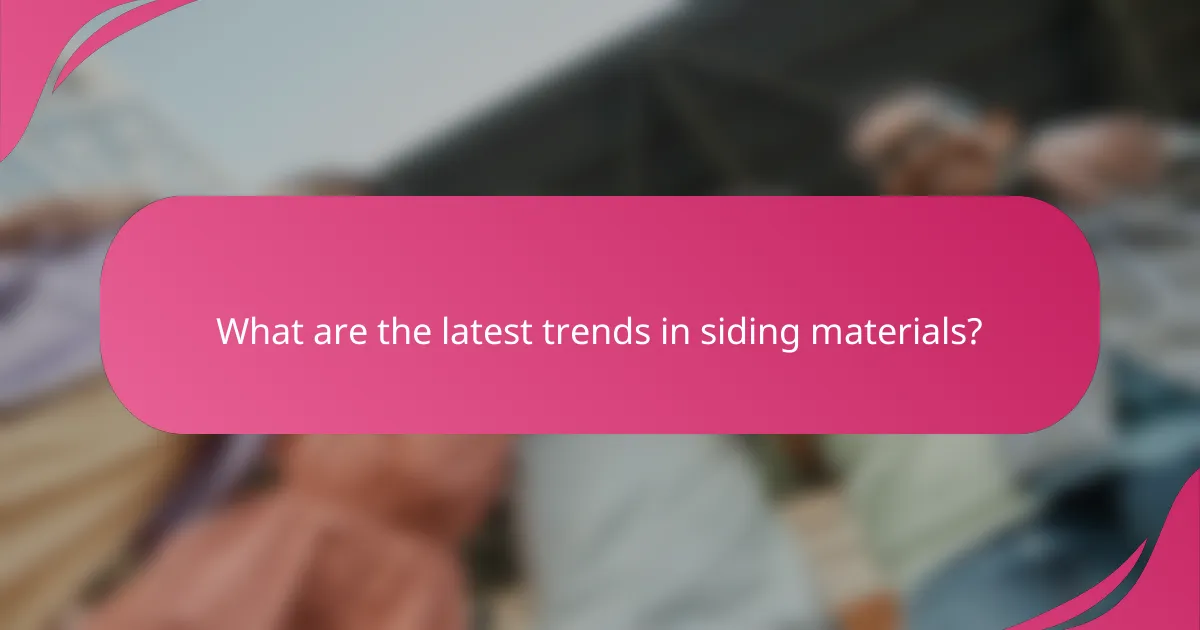
What are the latest trends in siding materials?
The latest trends in siding materials focus on enhancing aesthetics, improving insulation, and reducing maintenance. Homeowners are increasingly opting for materials that not only look appealing but also contribute to energy efficiency and require less upkeep over time.
Eco-friendly siding options
Eco-friendly siding options are gaining popularity as homeowners seek sustainable materials. Products made from recycled content, such as fiber cement and reclaimed wood, offer durability while minimizing environmental impact. Additionally, natural materials like cedar and bamboo are favored for their renewability and aesthetic appeal.
When considering eco-friendly siding, look for certifications such as FSC (Forest Stewardship Council) or Energy Star ratings, which indicate responsible sourcing and energy efficiency. These options can often lead to lower energy bills and a reduced carbon footprint.
Smart siding technology
Smart siding technology integrates advanced features that enhance home performance and convenience. For instance, some siding materials now include built-in insulation or moisture management systems that help regulate temperature and prevent water damage. This technology can significantly improve a home’s energy efficiency.
Additionally, smart siding can be equipped with sensors that monitor environmental conditions, alerting homeowners to potential issues like moisture buildup or temperature fluctuations. Investing in these innovative materials can lead to long-term savings and increased home value.
